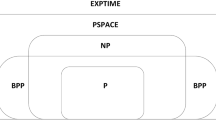Abstract
This paper aims to introduce the novel approach to the design of a class of decision-making tools based on belief networks for biometric applications. The problem is formulated as mapping the belief networks into the homogeneous computing network, in order to meet the requirements of real-time computing, in particular, the biometric-based physical access control system. The feasible approach to this problem is the accelerating of software computing using hardware. Our experiments show that the straightforward utilization of the hardware tools may not satisfy real-time applications, since the belief networks may not be mapped directly into the hardware. We propose generating the belief network based on mapping of the belief trees into the linear networks with further fusion, so that the obtained structures can be mapped into homogeneous computing arrays.






Similar content being viewed by others
References
DAPRA (2003) Total information awareness DAPRA’s research program. Inf Secur 10:105–109
Jensen FV (2001) Bayesian networks and decision graphs. Springer, Berlin
Larsen HL, Yager RR (2000) A framework for fuzzy recognition technology. IEEE Trans Syst Man Cybern Part C Appl Rev 30(1):65–76
Lyshevski SE (2007) Molecular electronics, circuits and processing platforms. CRC Press, Boca Raton
Pearl J (1987) Evidential reasoning using stochastic simulation of causal models. Artificial Intell 32:245–257
Pournara I, Bouganis C-S, Constantinides GA (2005) FPGA-accelerated Bayesian learning for reconstruction of gene regulatory networks. Proceedings of the IEEE international conference field programmable logic and application, pp 323–328
Shafer G (1976) A mathematical theory of evidence. Princeton University Press, New Jersey
Shmerko VP, Stoica A, Yager RR, Yanushkevich SN, Moon H (2007) Accelerating decision making support in biometric assistant for remote temperature measures. In: Proceedings of the ECSIS-2007 symposium on BLISS. Edinburgh, UK, pp 11–14
Shmerko VP, Yanushkevich SN, Lyshevski SE (2009) Computer arithmetics for nanoelectronics. CRC Press, Boca Raton
Yager RR, Fedrizzi M, Kacprzyk J (eds) (1994) Advances in the Dempster–Shafer theory of evidence. Willey, New York
Yager RR (2004) Uncertainty modeling and decision support. Reliab Eng Syst Saf 85:341–354
Yanushkevich S (2007) Logic design of computational nanostructures. J Comput Theor Nanosci Sci Am Publ 4(3):60–69
Yanushkevich SN, Stoica A, Shmerko VP (2006) Semantic framework for biometric-based access control systems. IEEE international conference on computational intelligence for homeland security and personal safety, Alexandria, VA, USA, pp 11–16
Yanushkevich SN, Stoica A, Shmerko VP (2006) Experience of design and prototyping of a multi-biometric early warning physical access control security system (PASS) and a training system (T-PASS). Proceedings of the 32nd Annual IEEE industrial electronics society conference, Paris, pp 2347–2352
Yanushkevich SN, Stoica A, Shmerko VP (2007) Fundamentals of biometric-based training system design. In: Yanushkevich SN, Wang P, Srihari S, Gavrilova M (eds) Nixon MS, (Consulting ed). Image pattern recognition: synthesis and analysis in biometrics. World Scientific, pp 365–406
Zadeh LA (1999) From computing with numbers to computing with words—from manipulation of measurements to manipulation of perceptions. IEEE Trans Circuits and Syst I Fundam Theory Appl 45(1):105–119
Acknowledgments
This Project was partially supported by the Natural Sciences and Engineering Research Council of Canada (NSERC), the Canadian Foundation for Innovations (CFI), the Government of the Province of Alberta, and the Alberta Informatics Circle of Excellence (iCore). A part of the Project has been implemented as an initiative within the JPLs Humanoid Robotics Laboratory and Machine Intelligence Institute, Iona College, New Rochelle, NY. The authors sincerely acknowledge a partial support from the US Department of Energy under the contracts Three-Dimensional Biomolecular Computing Architectures.
Author information
Authors and Affiliations
Corresponding author
Rights and permissions
About this article
Cite this article
Yanushkevich, S.N., Gavrilova, M.L., Shmerko, V.P. et al. Belief trees and networks for biometric applications. Soft Comput 15, 3–11 (2011). https://doi.org/10.1007/s00500-009-0512-3
Published:
Issue Date:
DOI: https://doi.org/10.1007/s00500-009-0512-3




